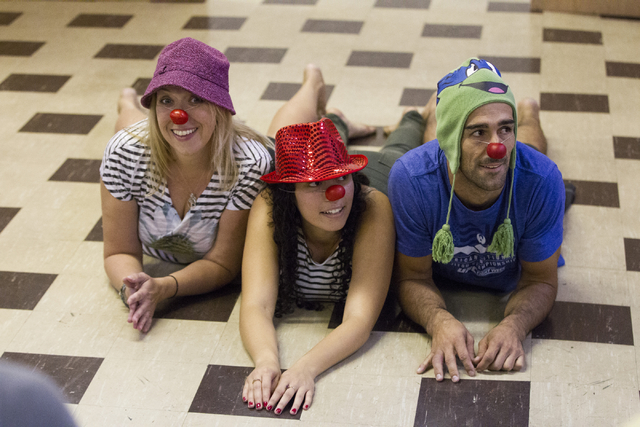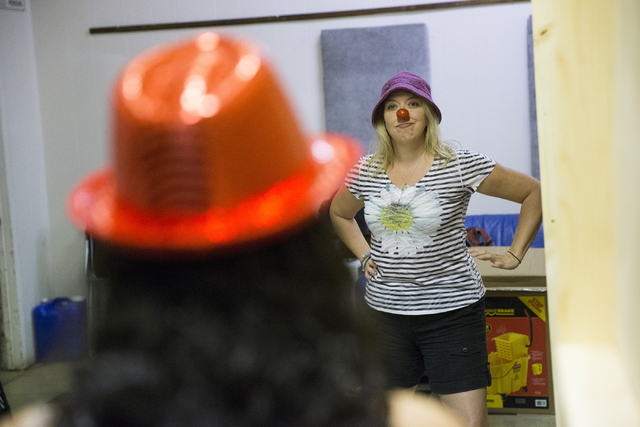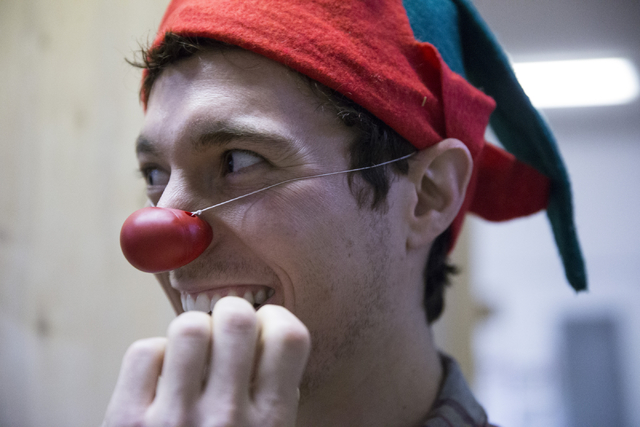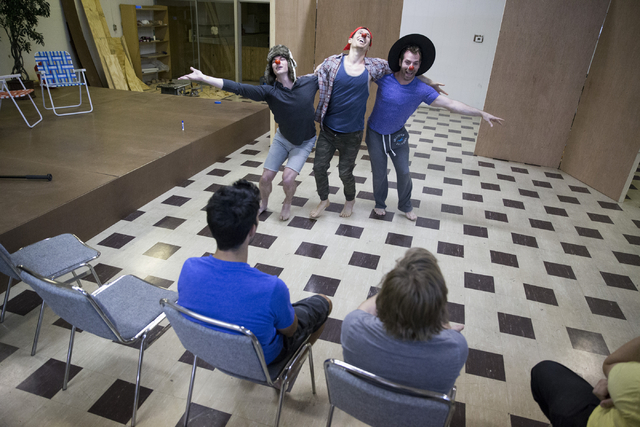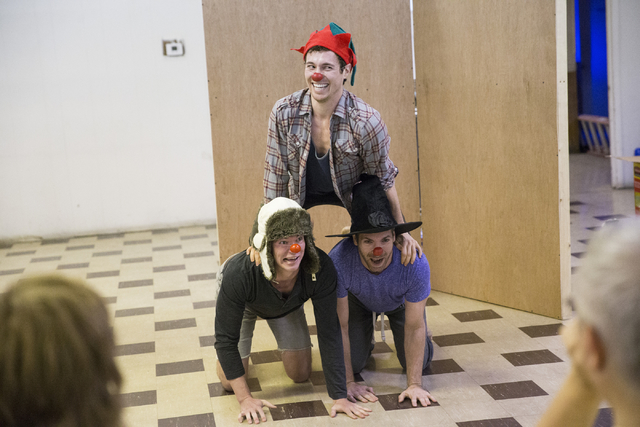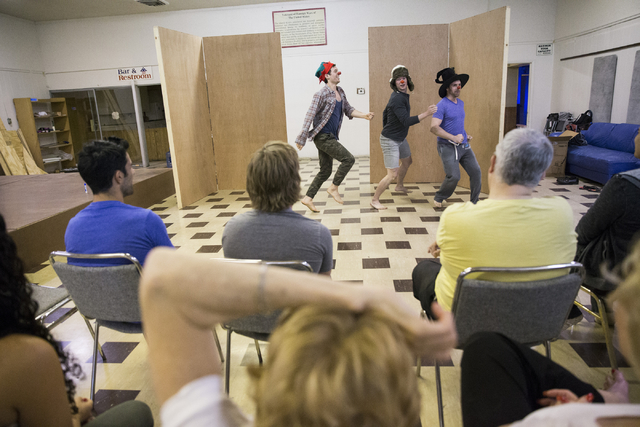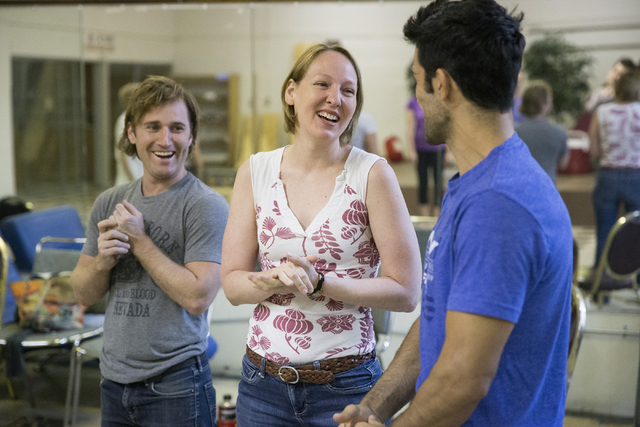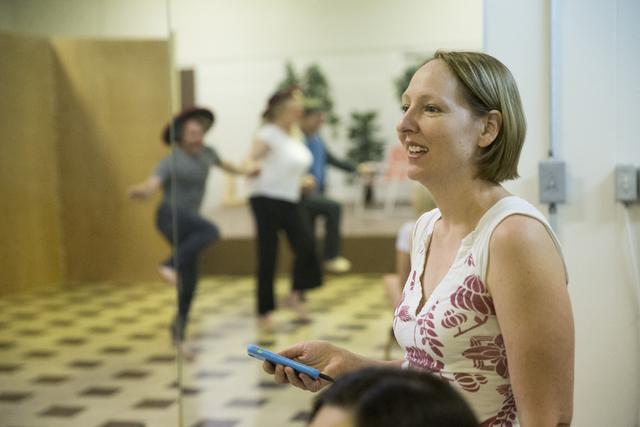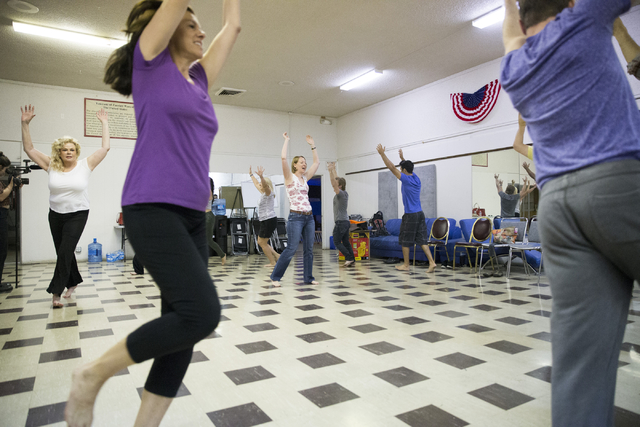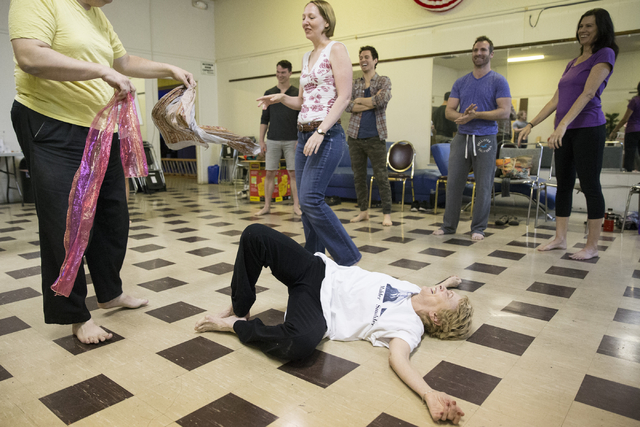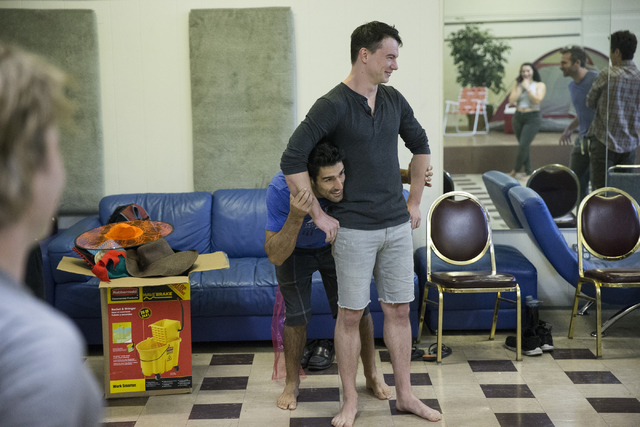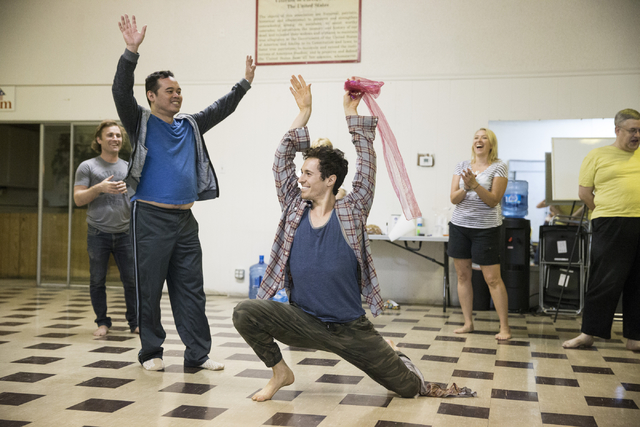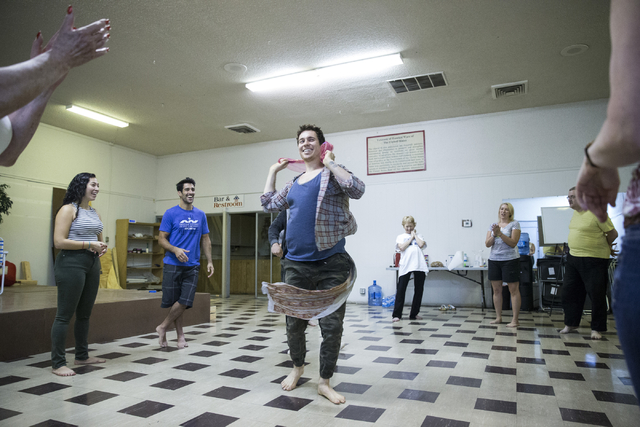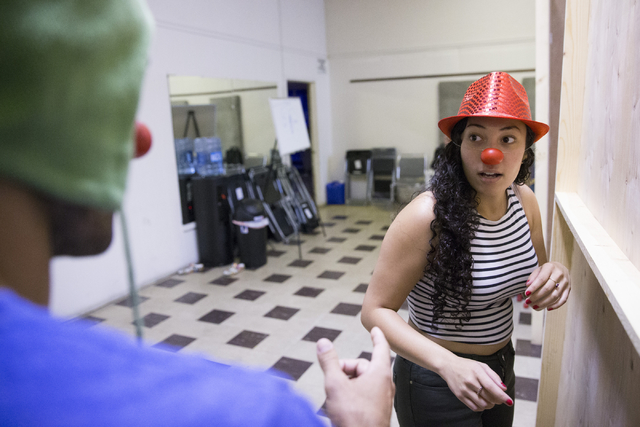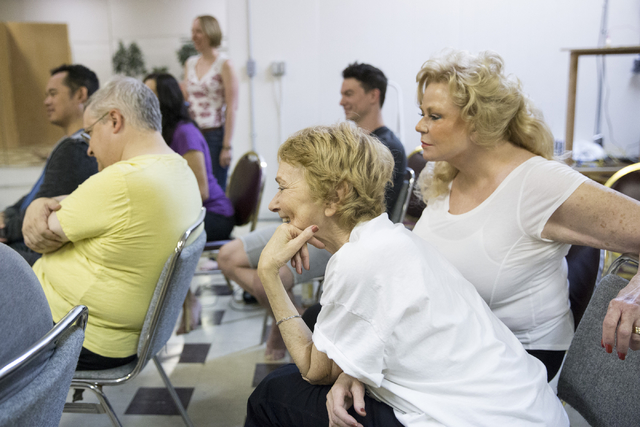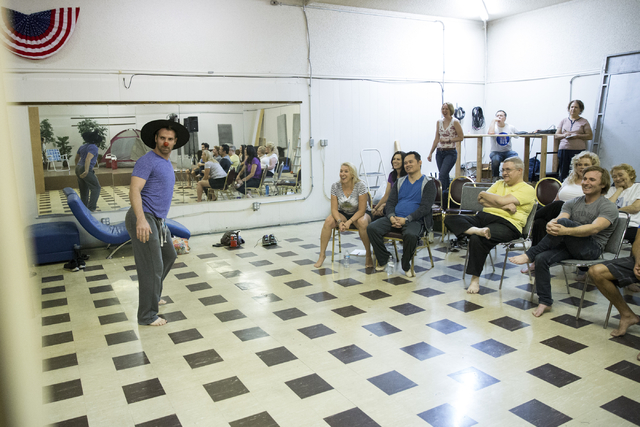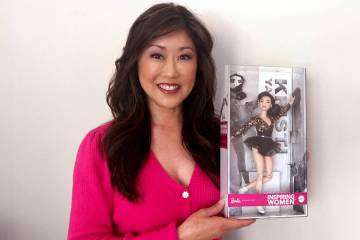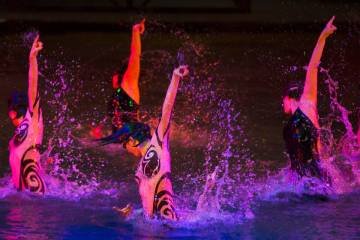Class teaches good points of playing the clown
Everybody knows about class clowns.
Clown class, by contrast, is something entirely different.
There’s plenty of laughter, to be sure, as 14 students — from Strip performers to retirees — gather weekly to learn the fundamentals of funny business.
Inevitably, those fundamentals include donning bulbous red noses and fanciful hats.
But the class also touches on less tangible elements, including embracing your flaws and finding your inner child — the one who knows how to play without overthinking the process.
“If you’ve been a child — and we all have — you’ve experienced play,” with “the innocence and total commitment” that accompanies the experience, instructor Shannan Calcutt explains just before she calls the class to order. “We all have a clown in us, waiting to come out.”
The introductory class began before reports of “creepy clown” sightings, but Calcutt decries the trend, calling the so-called clowns “disturbed people dressing up in a costume.” As she points out, “if they dressed up as police officers or firemen, they would say they were people disguised as firemen or police officers.”
Clowns “are there to make us forget our troubles,” she asserts. “Clown is a beautiful art form. … No clown I know would ever do anything like this.”
And Calcutt — whose “day job” involves clowning around in the cast of Cirque du Soleil’s “Zumanity” — should know.
GETTING DOWN TO FUNNY BUSINESS
As she calls this clown class to order, she instructs the students to remove their shoes and socks and form a circle.
They’re gathered at Vegas Theatre Hub, which offers a variety of improvisational classes at its new downtown headquarters, across from the Neon Museum.
The front room still bears multiple reminders of its former life as a Veterans of Foreign Wars post, including patriotic red-white-and-blue bunting that, come to think of it, could double nicely as circus decor.
It’s hardly accidental that the clown class takes place at Vegas Theatre Hub; creative director Darren Pitura, a fellow Cirque veteran, happens to be Calcutt’s husband. (They met while performing on the Canadian Fringe Festival circuit — she’s from Saskatchewan, he’s from Manitoba — and moved to Las Vegas 11 years ago when Shannan joined Cirque and Pitura started with the Flamingo’s Second City improv show.)
Calcutt rounds up the students for an exercise she calls “Jacques a Dit” — better known in these parts as “Simon Says.” (The French name comes courtesy of master teacher Philippe Gaulier, with whom Calcutt studied in Paris.)
As class members circle ’round, Calcutt issues commands — some prefaced by “Jacques a Dit,” some not.
“Who made a mistake?” she asks once the students stop. After ’fessing up to moving without hearing “Jacques a Dit,” each guilty class member must ask a fellow student for a kiss — or a hit. Some students ask, and receive, kisses on the cheek, along with hearty hugs. Others request — and get — a slap on the hand, the arm, or another (better padded) anatomical area.
Following “Jacques a Dit,” the class moves on to another exercise. Two by two, they enter the circle’s center and tuck long, colorful scarves into the back of their pants. The goal: snatch the other’s scarf. (Think “Rip the Tail Off the Donkey.”)
Initial participants employ a direct approach, circling briefly before getting down to business.
“If you’re watching and you’re bored, raise your hands,” Calcutt announces. Several students do just that, prompting the next two participants to up their game — twisting out of reach a la Twister, making eye contact with the audience. One even pulls his scarf between his legs for protection, triggering a round of laughter.
“When they started to take some risks, were you more interested?” Calcutt asks. “That was an awesome moment when she had his and he grabbed hers … and it was even more delightful to see her fail.” After all, “if the king falls, we love it.”
VULNERABILITY IS STRONG SUIT
As the game progresses, with the addition of music (from Offenbach’s cancan to “America” from “West Side Story”), pairs of participants dance tangos, use fellow students as shields, employ wrestling moves and otherwise heighten the excitement.
“You see the relationship,” Calcutt notes after one pairing. “We have the idiot and the queen. I love it. I could watch that all day.”
Calcutt urges the players to “really connect with your audience. In clown , the audience is also your partner.”
And throughout,”make yourself vulnerable,” Calcutt instructs her students. “You are always vulnerable. The joy is the vulnerability.“
The stakes get even higher during the third class exercise: a dance competition.
“In clown, it’s life or death,” Calcutt warns. “Your goal is to get everyone’s attention.”
In each round, three participants don hats — and noses — before emerging from behind wooden walls, making their grand entrances to disco hits of yore. Mid-competition, Calcutt announces that they’re no longer competitors, but teams of three, forcing them to improvise group moves before reverting to solo status.
Individually and collectively, students shake their groove thing, roll on the floor, form pyramids and prance around in striking headgear — black pointy witch hats, crowns, sequined fedoras, furry Elmer Fudd bomber hats, jester caps and black Spanish flamenco hats with red ball fringe. (To say nothing of those rose-red noses.)
“Even when you are three idiots moving like this, it totally looks choreographed,” Calcutt praises one group. “It’s so great — because it’s so bad.” After watching another trio, she observes, “you’re doing a bit of slapstick — not well, but it’s like soap opera acting. It’s so bad, we believe it.”
Following every exercise, Calcutt and her students break down what went right — and what went wrong.
“Your presence is so intense,” Wes Scarpias tells fellow student Lisa Illia.
“I love you,” Illia responds, deadpan.
And when Calcutt suggests to Roni Mahler (who’s wearing a T-shirt with two different-sized portraits of composer Gustav Mahler, emblazoned “Mahler Smahler”) that “you can work less here,” Mahler replies with a rueful “I always do too much.”
But not to worry.
“We’re doing comedy and clown,” Calcutt reminds the class members. “You’re going to fail more than you succeed. Give yourself that permission.”
At the end of the dance competition sequence, Calcutt shares a secret.
“I’ve been teaching 16 years — and this is the second time someone has not taken his clothes off during this exercise,” she says. “So bravo for not being naked. But you can take a little more risk.”
FINAL ANALYSIS
Taking a break during the three-hour class, some students gulp water, share snacks and ponder why they’re there.
Darin Good, an acrobat in Cirque’s “Ka,” has taken other Theatre Hub classes but finds the clown class “helps you get out of your comfort zone,” he explains. “It just refreshes you in your day-to-day work.”
Alex Buckner, a classically trained ballet dancer, and actor Michael Forsch perform together in Planet Hollywood’s “V — the Ultimate Variety Show” as the Quiddlers — and are taking Calcutt’s clown class together.
“You find the best version of yourself as a clown,” Forsch says. “I laugh the hardest when I am terrible as a clown.”
Illia, a community theater veteran, is “sort of retired” and has a lot of free time to indulge her affinity for performing.
For Alberto Del Campo, another “Ka” acrobat, Calcutt’s clown class “helps us in what we do a lot,” especially in onstage moments “where we have freedom to explore.”
Besides, “I always wanted to be a clown,” he adds. “It’s a lot of fun,” but “when you work with professional clowns, you realize how much work it is. It exercises different muscles.”
The break’s ending, and before class resumes, Sue Kane — who’s welcomed audience members to “Ka” for nine years as a Cirque gatekeeper — comments to no one in particular, “I wish this class could go on and on forever.”
The students are at the halfway mark — in the third of six classes.
Now that break’s over, it’s time for another exercise, another chance for Calcutt to remind them, “whatever you’re doing is perfect.”
After all, “in society today, we hide our faults and flaws,” she notes. “In clown, we celebrate them.”
Which is precisely why these class clowns are here.
“You learn to feel stupid,” Good says, “and enjoy it.”
Read more stories from Carol Cling at reviewjournal.com. Contact her at ccling@reviewjournal.com and follow @CarolSCling on Twitter.



